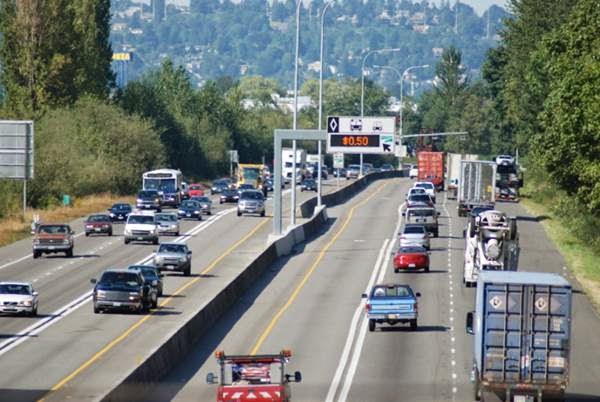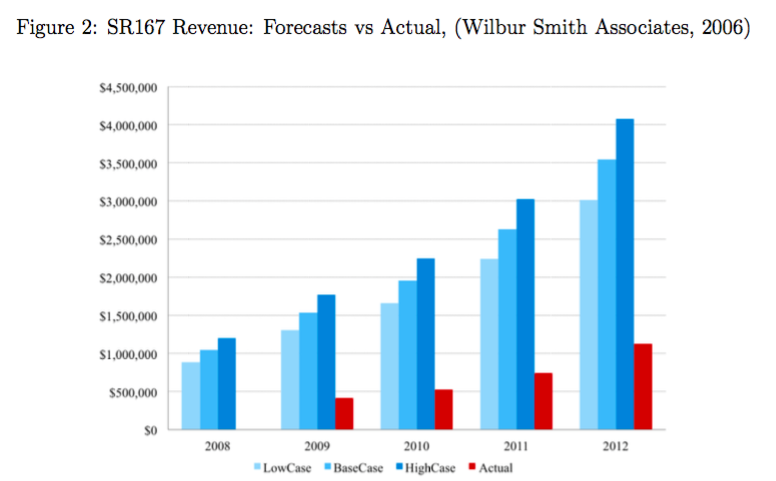Every year, the Texas Transportation Institute, and traffic monitoring firms like Inrix and Tom-Tom trot out scary sounding reports that claim that Americans lose billions or tens of billions of dollars worth of time sitting in traffic. And just as regularly, highway advocates parrot these dire sounding numbers as the justification for spending billions and billions on highway expansion projects (like a Texas plan to spend $70 billion in the next decade).
All these estimates and this case hinge on one crucial assumption: What dollar value travelers attach to time savings? But as a lawyer might argue, all of these studies are “assuming facts that are not in evidence.” Everyone complains about how awful and burdensome traffic congestion is, but when presented with an opportunity to buy a quicker trip, do people put their money where their mouth is? As we saw earlier this month in Louisville, given the opportunity to save several minutes time by paying a toll to use that city’s new, wider I-65 bridges, many travelers opted to save a few bucks by driving over the older, parallel–and un-tolled–highway bridge.
There’s a rule of thumb that travelers value their time at something close to half their wage rate. The 50 percent rule is based on statistical inference from studies of traveler behavior (“revealed preference”) and surveys of what people say they would do when confronted with a range of hypothetical situations (“stated preference”). There’s a range of estimates, centered mostly on 50 percent of the wage rate, which is the official standard used by the U.S. Department of Transportation, and works out to about $12.50 per hour (in 2009).
But what’s been lacking is solid, experimental evidence: when people are actually presented with a choice to spend some specific dollar amount to save a few minutes of travel time, do they actually pony up?
The implementation of high occupancy toll (HOT) lanes in a growing number of metropolitan areas provide us with exactly the kind of experimental evidence to evaluate travel times. A recent paper from the University of Washington’s Austin Gross and Louisiana State University’s Daniel Brent explores driver behavior on high occupancy toll lanes.

An important feature of these lanes is that they use dynamic pricing: the amount of the toll varies depending on the level of traffic. The system is calibrated to adjust the price every five minutes, and raises (and lowers) the price so that traffic in the HOT lane moves along at at least 45 miles per hour. When there’s light traffic, the toll is low; when traffic is heavier–and the HOT lane offers a faster trip relative to the road’s un-tolled lanes–the toll is higher.
Three years ago, Zachary Howard and Clark Williams-Derry at the Sightline Institute pointed out that preliminary data from Washington’s Highway 167 HOT lanes implied that travel time values were a lot lower than everyone suggested. They noted that most drivers were unwilling to pay any amount to speed up their trip, and the very small fraction of travelers that were using the HOT lanes were paying a toll that valued their time savings at something like $12 an hour, a figure that they came up with by dividing the number of minutes saved by the toll rate.
But Gross and Brent point out that the time savings are only part of the value: It’s not just a quick trip people want, it’s a reduction in uncertainty about when they’ll arrive. If you need to catch a plane, start a meeting, or open your shop at a certain hour, you’ll pay extra for the certainty of arriving on-time. It’s worth noting, for example than many more users pay tolls to use the HOT lanes in the morning–i.e. going to work–than they do in the afternoon–going home; this difference reflects the distinction between reliability as opposed to time savings. Reliability trumps time savings in most toll-payers calculus:
The main result is that VOR (value of reliability) is vastly more important than VOT (value of time); in fact in several specifications the VOT is insignificant. In the base specification the reliability ratio (VOR/VOT), is 7.5 indicating that reliability is much more important in using the HOT lane than time savings. These results suggest that the simple estimates of VOT on HOT lanes vastly overestimate the true VOT, and that much of the purchase decision is actually based on improved reliability.
Gross and Brent use data on about a million observed trips to estimate how much value the users of the system attach to their travel time savings and to the increased reliability of their trip. They estimate that the typical user values travel time savings at about $3 per hour, and reliability improvements at about $23 per hour. This estimate, particularly of the value of travel time savings is much lower than is regularly used in analyzing and justifying transportation investments.
Gross and Brent also use surveys of transponder owners, combined with census data to estimate the typical income of HOT lane users. Unsurprisingly, higher income households are much more likely to be HOT lane users–the median income of HOT lane users is over $100,000 annually, much higher than for commuters in the corridor. This is also important because it signals that even higher income households have a much lower value of time than is generally assumed in modeling and project evaluation.
Using too low a value of time means that DOTs overestimate the economic utility of projects–and also over-estimate the revenue that tolled projects produce. In the case of the Highway 167 HOT lanes, much lower value of travel time means that the HOT lanes have produced only about a third of the revenue that was projected before the lanes were opened.

If travelers attach so little value travel time savings, this calls into question the rationale for investing public funds in highway projects. Benefit-cost analyses used to justify highway projects count the estimated travel time savings, often valued at around $15 per hour, as the benefit of the project. If the real value of travel time savings is something like $3 an hour, that reduces the benefits by about 80 percent. So if a project had a benefit cost ratio of 5 to 1 under a $15 value of travel time assumption, it would essentially have no net value if travel time were valued at only $3 per hour.
As with Louisville’s new tolled bridges, the experience with HOT lanes is a kind of natural experiment that tells us how much value people attach to travel time savings. In the case of the HOT lanes, the economic evidence is that the tolling promotes greater efficiency, by giving those who value travel time savings–and actually travel time reliability–the option of paying for and getting a higher level of service. But it also suggests that many investments of scarce public resources in additional unpriced road capacity isn’t economically worthwhile for the travelers who use it.
